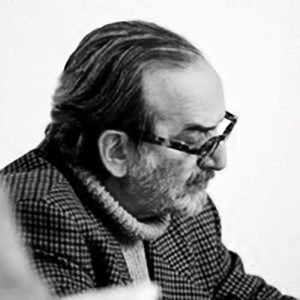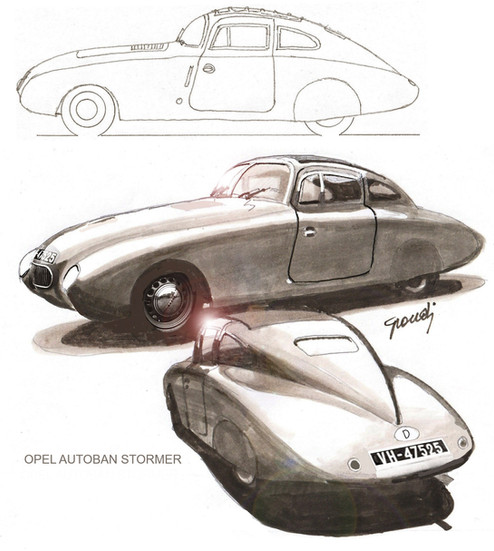Emile Darl'mat's Special Peugeots
- Massimo Grandi

- Sep 25
- 5 min read
Prof. Massimo Grandi retraces in this article the extraordinary story of Émile Darl’mat, the Parisian coachbuilder who, between the 1930s and 1950s, transformed Peugeot chassis into exclusive aerodynamic creations, from Le Mans racers to elegant postwar coupés.
Words and Drawings Massimo Grandi

Émile Eugène Henry Darl’mat was born in 1892. After learning the trade of mechanic from his cousin, he worked as a chauffeur for a businessman who first took him to the United States, and later gave him a loan when Émile decided to settle permanently. With that loan, he rented a small workshop near Les Invalides in Paris, where he began repairing cars of the marque La Buire.
By 1923, he had become an official Peugeot dealer, quickly distinguishing himself by offering customers not just sales and repairs, but also mechanical and aesthetic upgrades. By 1930, his Paris workshops already employed 160 people.
Darl’mat understood that to win customers he needed to offer something exclusive. He began creating bespoke, attractive cars that combined sporting performance with the ability to compete in demanding races such as the 24 Hours of Le Mans. To set his specials apart from standard Peugeots, he gave them a unique badge: the coat of arms of the city of Paris, supported by a lion’s paw with four claws, a nod to Peugeot’s own roaring lion emblem.

The First Peugeot Darl’mat
On the chassis of the 1936 Peugeot 302, with styling by Georges Paulin, the first Peugeot Darl’mat was born: the 302 DS.
Several Peugeot-Darl’mat 302 “Spécial Sport” models, fitted with the more powerful 402 engine, entered Le Mans in 1937 and 1938 with notable success.

Built in very limited numbers, the 302 Darl’mat was offered in three body styles: a roadster, a coupé, and a drophead coupé.
The first examples came out of Darl’mat’s Paris workshops. But by the mid-1930s, Peugeot had begun integrating these special-bodied coupés and cabriolets into its official lineup. From 1936 to 1938, production shifted to the Peugeot factory in Sochaux. In total, just 104 examples of the 302/402-based Darl’mats were built and sold across all body styles.
The outbreak of war in 1939 brought an abrupt halt. Production was suspended, and only in August 1944, immediately after the German surrender in France, did Darl’mat reopen his garage. The situation was desperate—raw materials were scarce across Europe. Peugeot managed to restart production in 1945 with the small 202, initially built almost entirely from prewar stock.

The Postwar Peugeot 202 Coupé
Darl’mat obtained a running 202 chassis, number 629844, and used it to build a lightweight, streamlined coupé.

Gone were the flamboyant, extravagant prewar “streamlined” forms. His 202 design looked decidedly more “Teutonic,” inspired by the German scientific approach to aerodynamics pioneered by Paul Jaray in the 1920s and refined by Koenig and Kamm.

The resemblance was clear to contemporary projects such as the Opel Autobahn Stromer of 1936 and the Maybach SW38 Stromlinie of 1938.
As Jaray had theorized, the 202, the Opel, and the Maybach were essentially built around two elemental volumes: a wing-section lower body with a constant longitudinal profile, and an upper “teardrop” cabin.

The result was a fully integrated body: pontoon fenders, flush-mounted headlamps positioned low in the nose, and smooth, continuous surfaces to minimize turbulence.
The car’s efficiency paid off. In 1947, with Charles de Cortanze at the wheel, the 202 Darl’mat set three 1,100cc class speed records at Montlhéry, including 1,000 miles at 144.5 km/h average and 2,000 miles at 145 km/h. It was displayed with pride at the Peugeot stand of the 1947 Paris Motor Show.
Yet despite the attention it generated, the 202 Darl’mat never entered production—not even as a small racing batch. Postwar shortages meant all available materials were reserved for France’s reconstruction.
The Peugeot 203 Darl’mat: A French Sports Sedan
After the war, Peugeot developed the 203, its first monocoque car, launched in 1948. It remained the company’s only model until 1955. Strong, comfortable, and reliable, the 203 was not a sports car—but Émile Darl’mat set out to change that.
In 1949, he unveiled a more muscular version of the 203, effectively creating a French take on the sporty sedan—anticipating, in spirit, what the 205 GTI would represent three decades later.

Darl’mat used the short-wheelbase version (435 cm overall, 258 cm wheelbase). Built at Sochaux, chassis and engines were sent to Paris for transformation. To distinguish it, Darl’mat lowered the roofline by 14 cm. Since the monocoque couldn’t be modified, he adjusted the suspension springs (dropping ride height by 7 cm) and reshaped the upper body panels.

The bonnet, roof, and windows were reduced in height, improving aerodynamics and road holding. The rear was redesigned with a subtle fin, while the grille took inspiration from contemporary Cadillacs, flanked by additional driving lamps.
Mechanically, the 203 Darl’mat remained close to factory spec, but lower, sleeker, and stronger—up to 75 hp from its 1.8-liter engine. Between 1949 and 1954, 135 examples were built, including a few rare 1952 cabriolets. On this foundation, Darl’mat produced one last streamlined variant: the Peugeot 203 DS.
The Peugeot 203 DS Darl’mat
Introduced in 1953, the Peugeot 203 DS followed the same philosophy as the earlier 202: a 203 chassis and uprated drivetrain clothed in an ultra-light, aerodynamic aluminum body. The car weighed just 600 kg, with cleaner, simplified lines compared to its predecessor.
The nose now featured a low, horizontal, elliptical intake framed by spotlights. Its teardrop tail recalled the futuristic Dubonnet Xenia, while the steeply raked windshield reinforced the impression of speed. Originally, it had gullwing doors like the later Mercedes 300 SL, but these were replaced with conventional doors after Montlhéry test sessions.

In 1953, Darl’mat and de Cortanze returned to record attempts. The 203 DS looked set to achieve its goals, but one hour before the finish a lightweight Borgo piston failed. The car was never raced again, for reasons that remain unknown.
The Unbuilt Peugeot 402 DS
In 1946, even before the 203, Darl’mat had envisioned an elegant new coupé based on the Peugeot 402 L chassis, no longer as a racer but as a grand tourer.
The design was sleek, aerodynamic, and refined—an evolution of the themes later seen in the 202 and 203 DS.

The proportions followed the same logic: a flowing teardrop cabin, integrated pontoon bodywork, and a distinctive oval grille. Longer at 4,760 mm and 1,370 mm tall, it promised to be an elegant, two-seat GT.
But it never left the drawing board. Postwar shortages and the 402’s aging technology consigned it to history.
Remarkably, its shape has since come to life: in 2010, Romanian coachbuilder Mebbero Automobile SRL of Cluj constructed a faithful Peugeot 402 DS coupé on an original 402 L chassis. Even the interior—missing from the original drawings—was recreated in the style of late-1930s Peugeots.

--
Massimo Grandi, architect and designer, previously director of the Car Design laboratory at the Design Campus of the Department of Architecture at the University of Florence. Member of the ASI Culture Commission. Among his published works: “La forma della memoria: il progetto della Ferrari Alaspessa”, “Car design workshop”, “Dreaming American Cars”, “Ferrari 550 Alaspessa: dall’idea al progetto”, “Quando le disegnava il vento”, “Il paradigma Scaglione”, “La più veloce: breve storia dei record mondiali di velocità su strada” (with others).












Comments